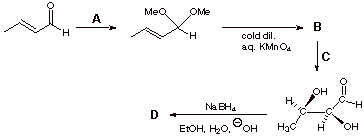![]()
![]()
1. Give a reasonable mechanism for each of the following reactions, clearly showing all important intermediates. Show movement of electron pairs with curved arrows.

2. Provide structures or reagents for A through D.

3. Give structures for E and F and explain how
they are consistent with the information given.
Compound E (C7H16O2) was optically active, did not have IR absorption
in the 1700 cm1 region, and did not react with Tollen's reagent
(Ag(NH3)2). When
E was treated with dilute aqueous HCl, neutral compound
F was obtained in addition to an equivalent each of methanol
and ethanol. Compound F had IR absorption at 1730 cm1
and reacted with Tollen's reagent to form a silver mirror. Upon
acidification of the Tollen's reagent reaction, butanoic acid
was isolated.
4. Consider and explain the following observations.
a. If excess benzaldehyde is used in the reaction below, large amounts of benzophenone and benzyl alcohol are formed, in addition to the expected diphenylmethanol. Benzophenone and benzyl alcohol are formed in 1:1 yield.
i. Remembering that reducing agents react with oxidizing agents, analyze this reaction in redox terms.
ii. Propose a mechanism for the formation of benzophenone and benzyl alcohol.

5. Propose methods for accomplishing the following conversions. Specify necessary reagents, reactants and conditions.
